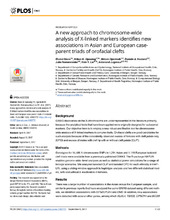| dc.contributor.author | Skare, Øivind | en_US |
| dc.contributor.author | Gjessing, Håkon K. | en_US |
| dc.contributor.author | Gjerdevik, Miriam | en_US |
| dc.contributor.author | Haaland, Øystein Ariansen | en_US |
| dc.contributor.author | Romanowska, Julia | en_US |
| dc.contributor.author | Lie, Rolv T. | en_US |
| dc.contributor.author | Jugessur, Astanand | en_US |
| dc.date.accessioned | 2018-03-01T14:45:49Z | |
| dc.date.available | 2018-03-01T14:45:49Z | |
| dc.date.issued | 2017-09-06 | |
| dc.Published | Skare Ø, Gjessing HK, Gjerdevik M, Haaland ØA, Romanowska J, Lie RT, Jugessur A. A new approach to chromosome-wide analysis of X-linked markers identifies new associations in Asian and European case-parent triads of orofacial clefts. PLoS ONE. 2017;12(9):e0183772 | eng |
| dc.identifier.issn | 1932-6203 | |
| dc.identifier.uri | https://hdl.handle.net/1956/17444 | |
| dc.description.abstract | Background: GWAS discoveries on the X-chromosome are underrepresented in the literature primarily because the analytical tools that have been applied were originally designed for autosomal markers. Our objective here is to employ a new robust and flexible tool for chromosome-wide analysis of X-linked markers in complex traits. Orofacial clefts are good candidates for such analysis because of the consistently observed excess of females with cleft palate only (CPO) and excess of males with cleft lip with or without cleft palate (CL/P). Methods: Genotypes for 14,486 X-chromosome SNPs in 1,291 Asian and 1,118 European isolated cleft triads were available from a previously published GWAS. The R-package HAPLIN enables genome-wide–level analyses as well as statistical power simulations for a range of biologic scenarios. We analyzed isolated CL/P and isolated CPO for each ethnicity in HAPLIN, using a sliding-window approach to haplotype analysis and two different statistical models, with and without X-inactivation in females. Results: There was a larger number of associations in the Asian versus the European sample, and similar to previous reports that have analyzed the same GWAS dataset using different methods, we identified associations with EFNB1/PJA1 and DMD. In addition, new associations were detected with several other genes, among which KLHL4, TBX22, CPXCR1 and BCOR were noteworthy because of their roles in clefting syndromes. A few of the associations were only detected by one particular X-inactivation model, whereas a few others were only detected in one sex. Discussion/Conclusion: We found new support for the involvement of X-linked variants in isolated clefts. The associations were specific for ethnicity, sex and model parameterization, highlighting the need for flexible tools that are capable of detecting and estimating such effects. Further efforts are needed to verify and elucidate the potential roles of EFNB1/PJA1, KLHL4, TBX22, CPXCR1 and BCOR in isolated clefts. | en_US |
| dc.language.iso | eng | eng |
| dc.publisher | PLOS | eng |
| dc.relation.uri | http://journals.plos.org/plosone/article/file?id=10.1371/journal.pone.0183772&type=printable | |
| dc.rights | Attribution CC BY | eng |
| dc.rights.uri | http://creativecommons.org/licenses/by/4.0 | eng |
| dc.title | A new approach to chromosome-wide analysis of X-linked markers identifies new associations in Asian and European case-parent triads of orofacial clefts | en_US |
| dc.type | Peer reviewed | |
| dc.type | Journal article | |
| dc.date.updated | 2018-02-07T13:21:18Z | |
| dc.description.version | publishedVersion | en_US |
| dc.rights.holder | Copyright 2017 The Author(s) | |
| dc.identifier.doi | https://doi.org/10.1371/journal.pone.0183772 | |
| dc.identifier.cristin | 1492054 | |
| dc.source.journal | PLoS ONE | |
| dc.relation.project | Norges forskningsråd: 262700 | |

